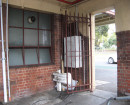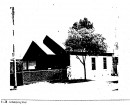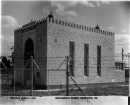Back to search results
BAARMUTHA HYDRAULIC SLUICING AREA
BUCKLAND GAP ROAD BEECHWORTH, INDIGO SHIRE
BAARMUTHA HYDRAULIC SLUICING AREA
BUCKLAND GAP ROAD BEECHWORTH, INDIGO SHIRE
All information on this page is maintained by Heritage Victoria.
Click below for their website and contact details.
Victorian Heritage Register
-
Add to tour
You must log in to do that.
-
Share
-
Shortlist place
You must log in to do that.
- Download report

Remnant pillar of unworked ground













On this page:
Statement of Significance
What is significant?
The Baarmutha Hydraulic Sluicing Area is a large and well-preserved example of historical alluvial gold mining in Victoria. The sluicing area begins near the junction of Three Mile and Six Mile Creeks, Beechworth and extends west along the Three Mile Creek for approximately 6.5 kilometres, extending over an area of approximately 140 hectares. The place includes sluicing voids or cavities, remnant pillars of unworked ground, sludge dams, water races, tail races, small dams and pebble dumps.
How is it significant?
The Baarmutha Hydraulic Sluicing Area is of historical, archaeological and representative significance to the State of Victoria. It satisfies the following criterion for inclusion in the Victorian Heritage Register:
Criterion A
Importance to the course, or pattern, of Victoria’s cultural history.
Criterion A
Importance to the course, or pattern, of Victoria’s cultural history.
Criterion C
Potential to yield information that will contribute to an understanding of Victoria’s cultural history.
Criterion D
Importance in demonstrating the principal characteristics of a class of cultural places and objects
Why is it significant?
Within the Baarmutha Hydraulic Sluicing Area, the remains of sludge dams are historically significant for demonstrating how miners were forced to manage the waste tailings from their operations from around the turn of the century with the introduction of the Mines Act 1904. The Act was introduced in part in response to the extent of sludge deposits downstream of the Three Mile Creek operations, with the reforms impacting future mining operations on a state, national and international level to this day.
(Criterion A)
The Baarmutha Hydraulic Sluicing Area is archaeologically significant for the extensive and well-preserved remains of alluvial gold mining, especially ground sluicing, in the form of large sluicing voids, water races, tail races, and pebble dumps. The place has the potential to yield significant new information about the historical mining industry with the use of geophysical, geochemical, geospatial and archaeological investigation and analysis.
(Criterion C)
The Baarmutha Hydraulic Sluicing Area is a notable example of an alluvial gold mining site in Victoria. The place clearly demonstrates the principal characteristics of a historical alluvial gold mining landscape. The place includes a large and deep sluicing void that reveals the nature and scale of alluvial mining along Three Mile Creek. The water races, tail races, pebble dumps and sludge dams are highly intact and easily understood examples of their type. Due to the length of mining operations at the site and the intersection of the Baarmutha Hydraulic Sluicing Area with the reform of environmental laws governing mining waste, the place is of a higher level of historical relevance than is typical of alluvial gold mining sites in Victoria.
(Criterion D)
Show more
Show less
-
-
BAARMUTHA HYDRAULIC SLUICING AREA - History
Gold discovery in Victoria
Gold was first discovered at several locations in Victoria during 1851, igniting one of the great nineteenth century gold rushes. People flocked to Victoria from around the world, with the population of the colony increasing from 77,000 to 540,000 in the decade to 1861. As the initial rush matured into a substantial mining industry, gold transformed Victoria into one of the richest places in the British Empire. Gold stimulated political reforms including universal male suffrage and the secret ballot. It also paved the way for widespread home ownership and underpinned the birth of the union movement. Few miners made fortunes, but most found the social and economic opportunity they craved. Victorian mines eventually produced around 78 million ounces of gold (approximately 2500 tons), representing two per cent of all the gold ever mined globally. The gold rush was one of the most important events in Australian history.
For First Peoples, Victoria’s gold rush was not a story of fortune or progress – it was a catastrophe. Mining was a force that tore through landscapes and lives, stripping riverbanks, gutting forests, and carving deep wounds into the earth. Sacred sites were desecrated. Land was excavated and exploited. The profits reaped would never flow to the very people who had cared for and stewarded the land for centuries. The gold rush did more than unearth precious metals: the theft of Aboriginal Country and its environmental destruction was part of the process of dispossession, as Victoria was rebuilt in the image of the Empire with the wealth generated from gold.[1]
Gold mining techniques
The gold rush in Victoria was based on two main types of gold sources in Victoria: quartz reefs and alluvial deposits. Quartz reefs are ore bodies hosting gold-quartz mineral veins deposited several hundred million years ago. Alluvial deposits comprise gold-bearing sands and gravels eroded into creeks and gullies from exposed quartz reefs. Most alluvial deposits in Victoria and around the world are geologically shallow, found within the top 20 metres or so of the ground surface. Victoria was unusual for also having ‘deep lead’ alluvial deposits where ancient rivers were capped by layers of basalt or sediment from later volcanic or depositional activity. Deep leads are generally more than 30 metres below ground level.
Alluvial mining
Alluvial gold in creeks and gullies was the easiest to find and recover, and formed the basis for early production on most goldfields during the 1850s. Miners used pans, cradles, rockers and puddling mills to separate gold from the washdirt. These techniques needed large volumes of water, and miners often went to great lengths to secure adequate supplies. Ground and hydraulic sluicing extended these methods from the mid-1850s onwards. In ground sluicing, miners diverted a flow of water over a working face to loosen the overburden and wash the dirt into long timber boxes lined with ripples to recover the tiny gold flakes. Hydraulic sluicing directed a flow of water into pipes that narrowed to a nozzle, with the high-pressure water blasting the washdirt into boxes to retr ieve the gold. Dredges worked directly in riverbeds and adjacent floodplains and used buckets on conveyor belts to lift the gravels and process them on a floating barge.
Deep lead alluvial mines processed the deposits in similar ways to shallow alluvial workings, using cradles, shakers and puddling mills. Miners first had to gain access to the gravels at depth and raise them to the surface. Where gravels had been consolidated into ‘cements’ they required crushing in stamp batteries before washing. Deep alluvial mining thus required the kinds of technology and equipment generally found in quartz mines to initially access and recover the deposits.
All kinds of alluvial mining produced vast quantities of semi-liquid waste or sludge, most of which remains deposited across the Victorian goldfields and downstream rivers today. There are five key types of alluvial mining:
1. Shallow workings: shafts up to 10 metres deep, often surrounded by piles of mullock or waste rock. Often close together, these workings characterise the small claim sizes of the early gold rush period. There may be puddling troughs nearby for treating heavy clays.2. Deep leads: shafts more than 30 metres deep and potentially 100s of metres below the surface, with a single large mullock heap and potentially footings from winding engines and other surface equipment.3. Ground sluicing: voids created by directing streams of water over the ground. Characterised by low cliffs (<5 m), ditches and dams, and large piles of cobbles on the base of the void.4. Hydraulic sluicing: voids created by high-pressure hosing to undermine hillsides; characterised by high, steep cliffs (>5 m) and large piles of cobbles on the base of the void, accompanying ditches and dams from the water supply system.5. Dredging: uneven, hummocky ground with no or poor topsoil.
Reef mining
Quartz reef mining involved the extraction of gold-bearing ore via shafts and tunnels and hauling it to the surface for processing. This involved the extensive use of boilers, steam engines, winders, and other machinery to dislodge the ore and to move personnel and mined material from the ore body to the surface. Once recovered, the ore was fed into the mortar box of a stamp battery and crushed into a sandy slurry, then forced onto amalgamating tables covered with copper sheets coated with mercury. The fine gold particles adhered to the mercury and water carried away the sand and minerals. The gold-mercury amalgam was then heated and smelted to refine the gold. The diverse and complex ores of the Victorian goldfields meant each mine had to adjust its processing techniques to extract as much gold as possible.
There are two key types of quartz reef mining:· Shaft and adit mining: reefs are accessed through vertical shafts or horizontal tunnels (adits) from the surface, with horizontal drives into the ore body. Surface evidence may include the opening to the shaft or adit, large mullock piles, machinery foundations and tailings (waste produced after processing). This is the most common form of quartz reef mining in Victoria.· Open cut mining: reefs are close to the ground surface and accessed directly. Surface evidence includes large voids, large mullock piles, machinery foundations, and tailings (waste produced after processing).
Beechworth goldfield
Prospectors found payable gold on tributaries of the Ovens River in February 1852 and within a year there were up to 8,000 diggers on the Ovens goldfield with administration centred on the town of Beechworth. The population of the goldfield increased to 12,000 in the late 1850s but declined thereafter. Substantial alluvial rushes in the district also occurred at Upper Nine Mile Creek (now Stanley), Lower Nine Mile Creek (now Yackandandah), Three Mile Creek (Baarmutha) and Reedy Creek. Further upstream along the Ovens River, gold mining also occurred at Myrtleford, Buckland, Bright, Wandiligong and Harrietville.
History of Three Mile Creek, Baarmutha
The Three Mile Creek goldfield at Baarmutha was worked by alluvial miners from 1852 until c.1950. The name ‘Barmootha’ was originally an Indigenous term for the place of several creeks (Woods 1985). The initial rush of miners worked the banks of the creek and gullies by the simple methods of potholing, pan and cradle, long toms, ground sluicing and puddling. The fine grains and flakes of gold that characterised the Beechworth goldfield were distinct from the nuggetty gold of central Victoria. This meant that miners needed large volumes of water to separate gold from the washdirt. Miners at Baarmutha initially paid carters to haul their washdirt to the nearest creek gully for washing, but water merchants soon constructed channels, or races, to deliver water to the miners’ claims, charging them for the water they provided. The population of the valley peaked in 1857, when more than 5,000 people were recorded in the census at Two Mile, Three Mile and Six Mile Creeks. As the easily accessible gold ran out, however, numbers dwindled and by the early 1860s the area was worked by a small number of Chinese miners.
John Martin Dietrich Pund was a sailmaker from Hamburg in Germany who arrived at Beechworth in 1854. Initially he was active at the Yackandandah (Lower Nine Mile Creek), Woolshed and Stanley (Upper Nine Mile Creek) diggings. He recognised the potential of the Three Mile Creek diggings if he could secure a reliable supply of water to the area. In 1865 he applied for a water right licence (No.58) and within five years he had constructed 19 kilometres of water race from Upper Nine Mile Creek to Three Mile Creek. This was the beginning of a successful sluicing company known as Pund & Co, which dominated the valley and produced many thousands of ounces of gold over the following 50 years.
Pund went into partnership with Ah Sam in several mining ventures (Hilderbrand 2011:334) and employed up to 20 men. The improved water supply from Pund’s race and others into the valley meant that Three Mile Creek quickly became known as a ‘sluicers’ paradise’. Long, fully boxed tail races, some more than one kilometre in length, ran down the valley and emptied into Hodgson Creek and down to the floodplain at Tarrawingee along the Ovens River. Pund later claimed to have installed 3400 metres of sluice boxes on Three Mile Creek (Board 1887). To realise his dreams fully, Pund became naturalised in 1873 so he could legally purchase land. He eventually became a substantial landholder in the district.
Ground or box sluicing relied on a channel of water directed over a working face, with timber sluice boxes set into a tail race lined with ripples to catch the tiny flakes of gold. A section of wooden fluming over a water race from c.1899 remains intact. There is no evidence that quicksilver (mercury) was used to amalgamate gold in these operations at Baarmutha. Teams of men shovelled washdirt into the boxes and forked out the cobbles and large gravels into stacks on site, while allowing finer sediment to wash through and into the creek downstream.
In 1874 Pund bought out Ah Gee’s mining leases and dam and several other leases at Three Mile Creek. He used Ah Gee’s dam for water storage until it filled with sludge and then built another reservoir upstream. Pund also obtained another water right licence (No.442) in 1881 to bring 950,000 gallons (3.5 ML) from the Upper Nine Mile Creek. This was one of several races that captured large volumes of water from tributaries of the Kiewa River and diverted them into the catchment of the Ovens River. By this stage Pund’s sluicing works were yielding upwards of 1000 ounces of gold per quarter (Mining Surveyor March 1883:28).
Pund was not the only sluice miner at Baarmutha. By the mid-1880s there were at least 17 water right licences held in the Three Mile Creek catchment, in addition to numerous unrecorded water privileges retained by holders of miner’s rights. Miners along the creek were licensed to capture and divert, in total, up to 47 million litres of water per day (Davies et al. 2019).
Pund also entered a partnership with John Alston Wallace in another Three Mile Creek claim. Wallace was a giant figure of mining in north-eastern Victoria. Born in Scotland in 1824, he migrated to Australia in 1852 and struck a rich claim at the Spring Creek (Beechworth) diggings (Woods 1976). A man of enormous energy and enterprise, Wallace used the profits to open stores and hotels and became a highly successful businessman. By the 1860s he was a shareholder in some of the largest sluicing claims in the district. He also invested in and developed mines at Stanley, Bright, Chiltern, Rutherglen, Bethanga, Harrietville, Myrtleford and beyond, and represented the North-Eastern Province in the Legislative Council from 1871 until his death in 1901.
In 1895 Pund and Wallace joined forces with William Telford’s United Sluicing Company. Telford was another water monopoliser who was also Chairman of Directors of the Rocky Mountain Extended Sluicing Company. This company sluiced the void that was later turned into Lake Sambell at Beechworth. The trio took over water right licence No.626, surrendered by Shand and Hambleton, which delivered 400,000 gallons (1.8 ML) per day from Upper Nine Mile Creek to Three Mile Creek. These amalgamations meant that the water races controlled by Pund & Co were now the major channels supplying the diggings at Three Mile Creek. John Pund’s water race system extended for up to 28 kilometres, diverting water out of the Upper Nine Mile Creek, across the headwaters of Spring Creek and into Three Mile Creek (Davies et al. 2016).
John Pund continued cutting new races in the 1890s to supply his expanding claims at Three Mile Creek. By this stage he held leases and miner’s rights over 60 acres of auriferous land (Board 1887:3). He also sold water to other miners at Three Mile Creek at the rate of 19 shillings per week in the late 1890s. Pund & Co continued working the Three Mile and Six Mile Creek diggings during the early twentieth century, averaging 1000 ounces of gold per year (Lloyd 2006:156). John Pund died in 1915 aged 81. His obituary described him as:
Being possessed of a master mind and tireless energy, Mr Pund soon became a mine owner, and as years rolled on he bought up and controlled almost the whole of the alluvial mining ground at the Three Mile and up the gully at the head of Buckland Gap [Six Mile]. He also possessed valuable water rights. Two or three years ago he expended a considerable sum in the purchase of several miles of large iron pipes to convey his race water from the hills to his claims at Three Mile. Wonderfully optimistic, energetic and resourceful, the late Mr Pund always saw success ahead of him, and few men have had more successes than came his way. He was a generous employer, who took a most kindly interest in his employees, many of whom spent all their working years in his employ (Ovens and Murray Advertiser 24 July 1915:3c).
After his death the company was taken over by his son, Percy but in 1919 he sold his interest, and the company became GSG Amalgamated. With John Weir as its manager, the company continued operations for 29 years, using water delivered by the races and pipes that Pund & Co had installed. In the 25 years to 1944, GSG Amalgamated produced 20,298 ounces of gold (Lloyd 2006:156). By the late 1940s, sluicing at Three Mile Creek was no longer payable and operations had ceased by around 1950. The combined gold yield of Pund & Co and GSG Amalgamated between 1865 and 1948 was over 45,000 ounces of gold (1.4 tonnes).
Baarmutha and environmental law reform in AustraliaAlluvial mining at Three Mile Creek, and the resulting sludge that flowed down to the Ovens floodplain at Tarrawingee, was at the heart of environmental law reform that began in the late nineteenth century. Half-hearted regulations had been in place to manage sludge on the goldfields since 1858, but it took until the Mines Act 1904 for effective environmental legislation to be passed to control the problem. During the 1870s, Shire Councillors at Wangaratta estimated that 10,000 acres of land had been inundated by sludge from sluice mining, especially by parties at the Three Mile Creek diggings. The Tarrawingee sludge channel was constructed at government expense to try to alleviate the problem. At the 1887 Sludge Board of Enquiry, John Pund bore the brunt of complaints from farmers in the district.
The government responded to years of complaints and lobbying about sludge by passing the Mines Act 1904, which finally made miners responsible for the waste they produced. It also created the Sludge Abatement Board to regulate sludge on the goldfields (Lawrence and Davies 2019). The aim and long-term effect of the laws was to protect land and waterways from sludge pollution. The new legislation required sluice miners to build large settling dams to consolidate the sediment before releasing the water back to the nearest waterway. Settling or sludge dams were the precursors of the large tailings storage facilities (TSFs) used around the world in industrial mining operations today (Hudson-Edwards 2016; Kossoff et al. 2014). John Pund built a series of sludge dams in the lower part of his claim at Three Mile Creek after being prosecuted by the Sludge Abatement Board in 1911. When Pund’s leases were acquired by GSM Amalgamated in 1919, the company continued with the use of sludge settling basins in the creek until the late 1940s.
Victoria was one of the first jurisdictions in the world to require on-site tailings retention. The sludge that John Pund mobilised from his sluice pits along Three Mile Creek was an important part of the problem, while the dams he and his successors built are highly significant as an early response to the legislation.
[1] Yoorrook: Truth Be Told, Yoorrook Justice Commission, Parliament of Victoria, June 2025, p.8 & 63.
Selected bibliography
Board 1887. Report of the Board Appointed by His Excellency the Governor in Council to Inquire into the Sludge Question. No.10, Parliament of Victoria, Melbourne.
Davies, P., Lawrence, S. and Turnbull, J. 2016. Beechworth goldfield and large-scale water management in colonial Victoria. Victorian Historical Journal 87 (2):237-260
Davies, P., Lawrence, S., Turnbull, J., Rutherfurd, I., Grove, J., Silvester, E. and Macklin, M. 2019. Mining Modification of River Systems: A case study from the Australian Gold Rush. Geoarchaeology 35(3):384-399.
Davies, P., Lawrence, S., Turnbull, J., Rutherfurd, I., Silvester, E., Grove, J, and Macklin, G. 2020. Groundwater extraction on the goldfields of Victoria, Australia. Hydrogeology Journal 28(7):2587-2600.
Hilderbrand, J. 2012, The Baarmutha Story, second edition, PB Publishing, Gisborne, Vic.
Hudson-Edwards, K. 2016. Tackling mine wastes. Science 352 (6283):288-290.
Kossoff, D., Dubbin, W.E., Alfredsson, M., Edwards, S.J., Macklin, M.G. and Hudson-Edwards, K. 2014. Mine tailings dams: Characteristics, failure, environmental impacts, and remediation. Applied Geochemistry 51:229-245.
Lawrence, S. and Davies, P. 2014. The Sludge Question: The Regulation of Mine Tailings in Nineteenth-Century Victoria. Environment and History 20:385-410.
Lawrence, S. and Davies, P. 2019. Sludge: Disaster on Victoria’s Goldfields, La Trobe University Press & Black Inc.
Lloyd, B. 2006. Gold in the North-East: A history of mining for gold in the old Beechworth Mining District of Victoria, Histec Publications, Hampton East, Victoria.
Mining Surveyor March 1883. Reports of the Mining Surveyors & Registrars for the Quarter Ended 31st March 1883. Parliament of Victoria, Melbourne.
Michael Pearson, 'From Ship to the Bush: Ship Tanks in Australia', Australasian Historical Archaeology, 10, 1992, pp. 24-19.
Turnbull, J., Davies, P. and Lawrence, S. 2015. Historical Archaeology of Water Management at Beechworth. Messmate Press, Melbourne.
Woods, C. 1976. Wallace, John Alston. In G. Serle and R. Ward (eds.), Australian Dictionary of Biography, volume 6, Melbourne, Melbourne University Press, pp. 345–6.
Woods, C. 1985. Beechworth: A Titan’s Field. Hargreen Publishing Company, Melbourne.
[1] Yoorrook: Truth Be Told, Yoorrook Justice Commission, Parliament of Victoria, June 2025, p.8 & 63.BAARMUTHA HYDRAULIC SLUICING AREA - Permit Exemptions
General Exemptions:General exemptions apply to all places and objects included in the Victorian Heritage Register (VHR). General exemptions have been designed to allow everyday activities, maintenance and changes to your property, which don’t harm its cultural heritage significance, to proceed without the need to obtain approvals under the Heritage Act 2017.Places of worship: In some circumstances, you can alter a place of worship to accommodate religious practices without a permit, but you must notify the Executive Director of Heritage Victoria before you start the works or activities at least 20 business days before the works or activities are to commence.Subdivision/consolidation: Permit exemptions exist for some subdivisions and consolidations. If the subdivision or consolidation is in accordance with a planning permit granted under Part 4 of the Planning and Environment Act 1987 and the application for the planning permit was referred to the Executive Director of Heritage Victoria as a determining referral authority, a permit is not required.Specific exemptions may also apply to your registered place or object. If applicable, these are listed below. Specific exemptions are tailored to the conservation and management needs of an individual registered place or object and set out works and activities that are exempt from the requirements of a permit. Specific exemptions prevail if they conflict with general exemptions. Find out more about heritage permit exemptions here.Specific Exemptions:1. All vegetation management excluding tree removal which has the potential to destabilise or damage the sluicing void, water races or tail races.2. Installation of new Parks Victoria wayfinding/directional, informational and heritage interpretation signage.
-
-
-
-
-
BAARMUTHA HYDRAULIC SLUICING AREA
 Victorian Heritage Register H2466
Victorian Heritage Register H2466 -
CHINAMAN'S FLAT ALLUVIAL WORKINGS
 Victorian Heritage Inventory
Victorian Heritage Inventory
-
..esterville
 Yarra City
Yarra City -
1 Alfred Crescent
 Yarra City
Yarra City -
1 Barkly Street
 Yarra City
Yarra City
-
-










